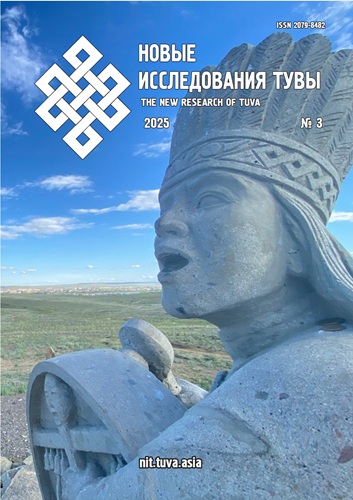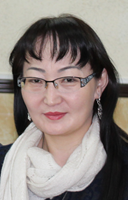Research into the themes covered in Pandita Jamyangarav’s compilation of sources from the time of the Mongol khans
DOI:
https://doi.org/10.25178/nit.2025.3.26Keywords:
lama; Tibetan language; Pandita Jamyangarav; Mongols; Buddhism; seal of Genghis Khan; Buddhist teacherAbstract
This article analyzes the content of the work “The Lineage of the Mongol Khans in Mongolian Texts” written in the late 19th / early 20th centuries by Pandita Jamyangarav (1867–1918), a Mongolian monk, poet, philosopher and scholar. This work provides valuable source materials for Mongolian history and an account of the khans of the Golden lineage of Mongolia. It contains interesting stories and information unrecorded in previous historical accounts and is of particular interest because it was written in Tibetan. It is also a valuable source for the history of the spread of Buddhism in Mongolia.
The history of Mongolia is remarkable because it was transmitted mainly orally rather than through writing. As a result, stories and oral traditions always add to the historical material that is passed down through the scriptures. However, very few Mongolian historical texts have been written in the Tibetan language. It is distinguished by the language’s shortened writing.
Although this text, or one bearing a similar name, is mentioned in some lists of Pandita Jamyangarav’s works, it includes valuable materials which is introduced in the context of Mongolian culture and history for the first time. It has been translated into Mongolian, its textual and scribal errors have been rectified, and it has been made available for scholarly analysis.
References
Bazarov, B. V. and Niam-Osor, N. (2003) From the history of the Mongol state symbolics. Etnograficheskoe obozrenie, no. 2, pp. 62–68. (In Russ.).
Hurelbaatar, L. (1996) On the branches of Kalpavriksha [Wish-Fulfilling Tree]. In: Cosmic White Garuda. Ulaanbaatar. Vol. I. Pp. 238–284. (In Mongolian).
Sain ugsiin san [Chronicles of ancient Mongolian literature] (1995) / Hevleld beltgesen L. Hürelbaatar. In: Mongolyn uran zohiolyn deejis. I boti. Ulaanbaatar, Suhbaatar Ulsyn Hevleliin Uildver. Pp. 440–443. (in Mongolian).
Tserensodnom, D. (1975) Poetry theorist Jamyangarav. Linguistic Research, vol. XI, pp. 240–244.
Published
How to Cite
Для цитирования:
Dashlkhagvaa G., UlamsurenTs. and Saaya O. M. Research into the themes covered in Pandita Jamyangarav’s compilation of sources from the time of the Mongol khans // Новые исследования Тувы. 2025. № 3. С. 438-447. DOI: https://doi.org/10.25178/nit.2025.3.26
Issue
Section

This work is licensed under a Creative Commons Attribution-NonCommercial 4.0 International License.

Author(s) license holder(s) grant rights for their work to the journal (grantee of a license) under the simple non-exclusive open license in accordance with Art. 1286.1 «Open license for a research work, work of literature or fine arts», Civil Code of the Russian Federation.
New Research of Tuva publishes articles under the Creative Commons Attribution-NonCommercial license (CC BY-NC).
Since it is an open license, author(s) reserve the right to upload the article to their institutional repository, submit it to another journal (if it allows republications), or republish it on their own website (in full, or in part).
However, several conditions apply here:
a) The republished version must always contain the name(s) and affiliation(s) of the author(s), the original title and the hyperlink to the original version on the New Research of Tuva website;
b) It must be in open access, free of charge, and no category of readers must be in any way whatsoever advantaged over general readership.
c) should the contribution be submitted elsewhere by its author(s) without substantial modification (30% or more of original text unchanged), the body of the article should contain a disclaimer that the original version was published in New Research of Tuva (with a link to the respective page)
The CC-BY-NC is a non-revocable license which applies worldwide and lasts for the duration of the work’s copyright.











